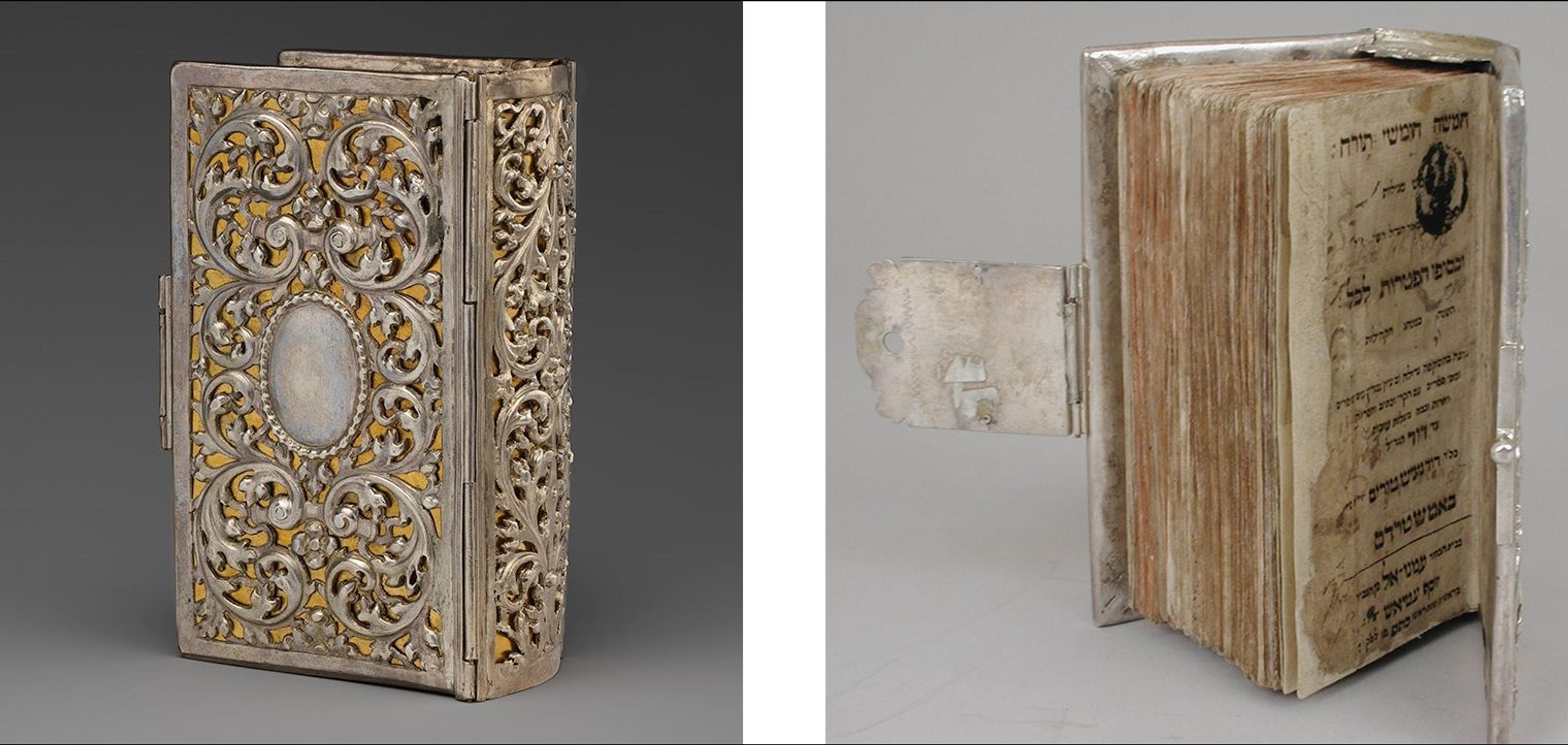Celebrating Shavuot and the Art of the Torah

Left: Andrea Zambelli "L'Honnesta" (Italian, active 1732–1772). Torah crown (keter), ca. 1740–50. Italian, Venice. Silver, parcel gilt, 10 3/4 x 12 3/8 x 12 3/8 in. (27.5 x 31.4 x 31.4 cm). The Metropolitan Museum of Art, New York, Purchase, Director's Fund, 2013 (2013.443). Right: Andrea Zambelli "L'Honnesta" (Italian, active 1732–1772). Pair of Torah finials (rimonim), ca. 1740–50. Italian, Venice. Parcel-gilt silver, both 26 5/8 x 6 1/4 x 6 in. (67.5 x 15.7 x 15.2 cm). The Metropolitan Museum of Art, New York, Purchase, Walter and Leonore Annenberg Acquisitions Endowment Fund, 2016 (2016.416, .417)
Three works of art on display at The Met celebrate the Jewish holiday of Shavuot ("Festival of Weeks"), which falls this year from June 8 through 10. The holiday commemorates a momentous event from the book of Exodus, when the Israelites received the Torah on Mount Sinai. The Torah, also known as the Pentateuch, contains the first five books of the Hebrew Bible and narrates the biblical history of the Israelites. It is considered the most sacred text in Judaism.
At first glance, this crown looks fit for a king or queen, its precious materials, elaborate craftsmanship, and grandeur signaling royalty. Yet, with an associated pair of finials—both on view in gallery 508—it was meant to adorn a Torah in a Jewish synagogue in Padua, Italy. Intended for communal use, the Torah attaches to two wooden staves with handles that allow the cantor to easily roll and unroll the parchment scroll to the designated reading portion. The finials fit over the two staves and the crown surrounds these finials.
Stylistic attributes of the late Baroque and Rococo periods embellish this crown and pair of finials, notably lavish arrangements of flowers, fruits, and shells. Yet these objects for the Torah are also decorated with Judaic motifs, such as the Tablets of Law, engraved with the Ten Commandments, and priestly garments referencing worship in the ancient temple in Jerusalem. These miniature emblems are all labeled with Hebrew inscriptions identifying that particular ritual object with its Judaic function.
We can imagine the Torah, adorned with the crown and finials, processing through the congregation and enriching the ceremony with visual splendor. Bells hanging from these finials are a reminder of the bells of the high priest's garment. The sound emanating from these bells as they moved with the Torah surely would have enhanced the spectacle.

Tobias Schier (Polish, active 1702–33). Book cover for Pentateuch and Five Scrolls, silver: 1721–ca. 1727; book: 1699–1701 and 1700–1701. Polish, Breslau (Wrocław). Silver, chased, pierced, embossed, and partially gilt, 5 5/8 x 3 1/2 x 2 1/4 in. (14.3 x 8.9 x 5.7 cm). The Metropolitan Museum of Art, New York, Purchase, Ruth and Andrew Suzman Gift, 2017 (2017.59)
A small but splendid book cover celebrates the Torah. This personal book could have been used by an individual in synagogue to follow the cantor's public reading and also at home in private devotion for further study. The book itself contains the Hebrew Bible, including the book of Ruth, which is traditionally read publicly as part of the Shavuot services, and selections from the book of Prophets.
This is not just any book cover. Pierced silver rendered in a late Baroque pattern of scrolling foliage—an elegant labyrinth of metalwork—is set against a gilded silver background. This contrast radiates the work in gold and silver tonalities. Such ensembles were highly sought after in early modern Europe. Considered luxury objects, they were often given as wedding presents.
Whether for public or private use, these works highlight how art enriched, and continues to enrich, Jewish ritual by infusing it with visual tropes of Judaism and exceptional craftsmanship, integrated in the style of the age and intended to dazzle the eye.
For more Torah adornments, visit this pair of Georgian Torah finials currently on view in gallery 556, or the exquisite Torah binder from Italy, which is beautifully illustrated online.
Related Content
Learn more about Judaism in The Met collection on the Heilbrunn Timeline of Art History.
Explore a Spanish Hebrew Bible on MetCollects.
Abigail Rapoport
Abigail Rapoport is a research associate for Judaica in the Department of European Sculpture and Decorative Arts.